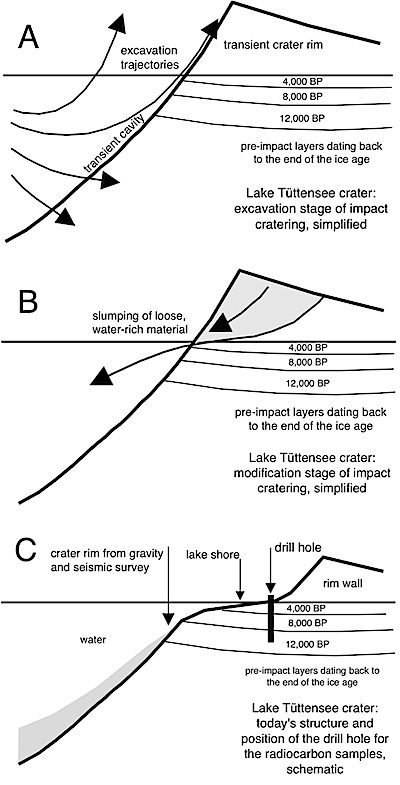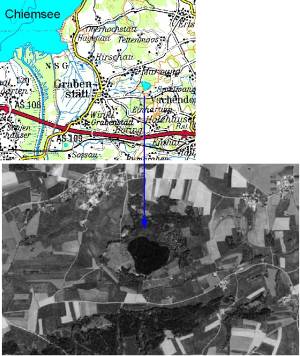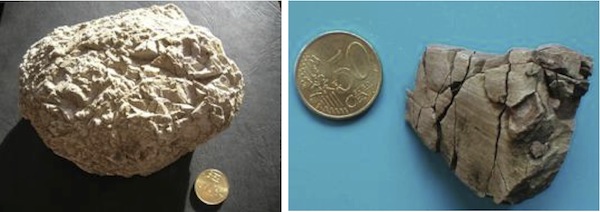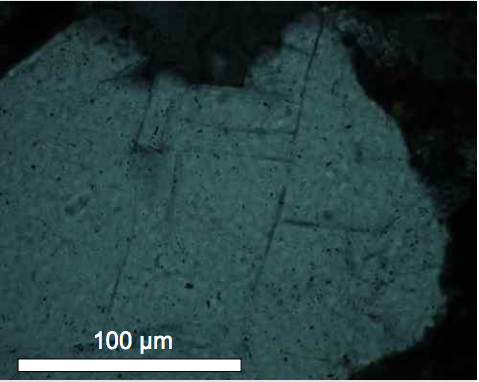Some new topics have come to be known since the original publication on this website:
— Many of the new results of the investigations of the Lake Tüttensee crater have been summarized in this lengthy article: http://elib.sfu-kras.ru/bitstream/2311/1631/1/04_.pdf
— The designation of the “largest crater” in the Chiemgau impact strewn field may no longer hold true after the discovery of the 900 m x 500 m rimmed doublet crater in lake Chiemsee (see here).
— Meanwhile more than 60 excavation pits around Lake Tüttensee have revealed impressive insight into the ejecta blanket of the crater mostly composed of a polymictic breccia up to one meter thick rich in organic material like splintered wood, charcoal, fractured teeth and bones, and tufts of (human?) hair. Moderate to strong shock effects in a large number of the breccia clasts underline the meteorite impact formation of the Lake Tüttensee crater. Stone artifacts and ceramic shards intermixed in the breccia enabled a dating of the event to the Bronze age or younger also clearly dismissing the dead-ice hypothesis of the local and regional geologists,
— From the gravity and seismic measurements on Lake Tüttensee (see the Geophysics contribution) and new topographic considerations, the impact structure is shown to have a 600 m rim-to-rim diameter and a much smaller true crater (diameter of about 300 m) hidden in the 400 m-diameter lake. The larger rim diameter is easily explained by the very soft target of loosely bound, water-saturated sediments that on excavation formed a strongly unstable rim wall. In the modification state of cratering, large amounts of this transient rim wall slumped inwards partly refilling the transient cavity (see the image below).
Lake Tüttensee meteorite crater formation (simplified) and location of the borehole for radiocarbon dating. First published in Antiquity 85, 2011, p. 279 (http://antiquity.ac.uk/ant/085/ant0850278.htm).
This model of crater formation is well compatible with the seismic measurements showing that the lake bottom is completely different from what is expected for a “classic” lake in the post-glacial landscape of the Alpine foreland thus once again dismissing the theory of a dead-ice kettle still claimed for the formation of the Lake Tüttensee crater by local and regional geologists. Moreover, from the seismic results it is evident that the drill core taken by geologists from the Bayerisches Landesamt für Umwelt (LfU) for radiocarbon dating of Lake Tüttensee sediments represents a completely normal stratigraphy outside the very crater (see the image above). Hence, the boastfully propagated message of the LfU that the radiocarbon dating has “killed” the impact hypothesis was all for nothing.
******************************************************************************************************************
Lake Tüttensee – the largest crater of the strewn field (original contribution)
Introduction
With regard to the Chiemgau impact event, the 400 m-diameter Lake Tüttensee (Fig. 1, 2) is so far considered the largest crater. It is located near Grabenstätt village not far from Lake Chiemsee. Its position at the southwestern end of the strewnfield together with other craters of larger size reflects the theoretical distribution of meteorite craters within a strewn ellipse, that is, on average, increasingly larger craters in the direction of the impact trajectory (see The Chiemgau strewnfield compared to others worldwide).
Fig. 1. Lake Tüttensee on the topographic map and as satellite imagery (DSat2).
Fig. 2. Aerial photograph of Lake Tüttensee. (Photo: Gerhard Benske).
According to official data, the lake has an average depth of about 10 m and a maximum depth of 17 m. This is contrasting with an unconfirmed depth of 70 m apparently plumbed by divers. From a gravity measurement on the frozen lake it appears that neither the official nor the unconfirmed depth applies. A depth of 20 – 30 m seems to be plausible, and the difference between these figures and the official depth may be explained by a thick layer of strongly consolidated organic matter.
Lake Tüttensee is surrounded by a distinct 8 m-height rim wall (Figs. 3, 4, 5) that gave an early hint to study Lake Tüttensee as a possible meteorite crater..
Fig. 3. The Tüttensee rim wall as seen from outside (view from the south).
4. An artificial cut through the Tüttensee rim wall.
Fig. 5. The Tüttensee rim wall as seen from inside. Photo taken during a gravity campaign on the frozen lake.
Previous to the discovery of the impact phenomenon, Lake Tüttensee was generally considered a Pleistocene dead-ice depression, obviously without any geologic investigation. Regional geologists and geologists from the Bavarian Geologic Survey (e.g., Doppler & Geiß 2005 continue to stick to this interpretation. The defense of the dead-ice origin is based on a short field trip and on a topographic model of the landscape, and their opposition is maintained despite the clear impact evidence provided by the impact research team (CIRT 2005, Ernstson 2005).
The reaction of the dead-ice advocates is the typical reaction that is observed in the history of impact research since 100 years. The reaction begins to work, when a new meteorite crater, a new impact structure has come on the scene: The new discovery is incompatible with the previous models of the regional geology. Indirectly, the discovery implies the reproach that the previous regional-geologic studies have overlooked the impact. In more detail, this controversy with special reference to the article of Doppler & Geiß (2005) is discussed in CIRT (2005).
Here, we present a discussion of both the dead-ice and impact model with a special focus on the new investigations clearly speaking in favor of an impact origin for Lake Tüttensee.
Dead-ice moraines – dead-ice depressions
are well known from all glaciation areas on the earth (Figs. 6, 7, 8, 9). When glaciers come to standstill and retreat, ice bodies may separate (Fig. 10 A) – they become “dead ice”. On burial by fluvial glacier deposits, they get isolated from warming and sun radiation and thus can survive for a long time (Fig. 10 B). Final melting causes the fluvial deposits to sink, and depressions – the dead-ice depressions – are formed (Fig. 10 C) frequently hosting lakes. In a few cases dead-ice depressions may be surrounded by hills forming a ring-like pattern. Such a morphology is explained by a different melting in the center and at the periphery of the buried ice body.
Fig. 6. Dead-ice depressions in Lapland/Sweden
 Source: http://www.hi.is/~oi/glacial_geology_photos.htm
Source: http://www.hi.is/~oi/glacial_geology_photos.htm
Fig. 7. Dead-ice depressions on Iceland.
 Source: North Dakota Geological Survey
Source: North Dakota Geological Survey
Fig. 8. Dead-ice depressions in North Dakota (USA).
 Source: North Dakota Geological Survey
Source: North Dakota Geological Survey
Fig. 9. Individual dead-ice depression in North Dakota (USA).
Fig. 10. Stages of the formation of dead-ice depressions. Upon standstill and retreat of a glacier, ice bodies may separate (A) – they are “dead ice”. On burial by fluvial glacier deposits, they get isolated from warming and sun radiation and thus can survive for a long time (B). Final melting of the ice causes the fluvial deposits to sink, and depressions – the dead-ice depressions – are formed (C).
Meteorite craters – impact structures
The formation of meteorite craters is largely understood today (Fig. 11).
Fig. 11. The stages of the formation of a simple, bowl-shaped meteorite crater. Upon impact of a cosmic projectile, shock waves carrying extreme energy propagate into the ground (A). They initiate vaporization, melting and crushing of the rocks, excavation of a crater, and ejection (B). After pressure release, a crater remains with more or less strongly shattered rocks at the floor and in a rim wall (C). Also see text.
A projectile (the impactor) sized > 10 – 20 m passes the atmosphere with practically unlimited cosmic velocity. On impact, enormous pressures are produced propagating as shock waves into the ground but also into the projectile (Fig. 11 A). The shock pressures are related with extreme temperatures sufficient to vaporize the penetrating impactor in a giant explosion. At the same time, a comparable volume of the target rocks is vaporized and also melted. On propagation of the shock waves, this volume rapidly increases to form a crater. Under high pressure, rock material is pressed against the floor and the walls of the growing cavity, more and more deformed, fractured and brecciated, and partly ejected (Fig. 11 B). A crater rim wall is formed surrounded by a blanket of ejected material. After shock wave passage, the pressure release causes counter movements at the crater floor flattening the cavity and leaving a lens of brecciated material at the floor (Fig. 11 C). In impact research, such a bowl-shaped structure is termed a simple crater.
Excavation cavities exceeding a diameter of a few kilometers behave somewhat different. On pressure release in the late stage of the impact cratering process, an additional collapse of the giant cavity occurs producing a central uplift or/and inner rings thus defining a so-called complex crater. The 25 km-diameter Ries impact structure in Bavaria is such a complex crater.
During the just outlined cratering process of the impact of a large meteorite, the shock waves are the most important characteristic. They conduct the movements of the rock masses during the growing of the excavation cavity, and they leave typical deformations in rocks and minerals otherwise unknown from geological processes.
Lake Tüttensee – a glacial dead-ice depression or a meteorite crater?
What are the features speaking in favor of a dead-ice depression? Lake Tüttensee is located in a landscape overprinted by glaciation where dead-ice moraines belong to the normal morphological inventory.
What are the features speaking in favor of a meteorite crater? Lake Tüttensee has a regularly formed rim Wall. The rounded but not circular shore (Figs. 1, 2) may be explained by the impact of a disintegrated projectile. Distinctly non-circular craters are known also from the Henbury and Kalijaarvi strewnfields. The regularly formed rim wall (Figs. 3, 4, 5) is compatible with a central impact explosion rather than with the irregular melting of a dead-ice body. Nevertheless, Doppler & Geiß (2005) refer to the morphology as in proof of a dead-ice depression. Here we note that the morphology is one of the least significant criteria for the characterization of a structure to be of impact or non-impact origin.
Doppler & Geiß (2005) also refer to some geologic depositional pattern recognized on their trip around Lake Tüttensee and seen in a gravel pit. Their observations are little meaningful only. It has always to be pointed out that in the course of an impact, geologic processes are going off (sedimentation, erosion, folding, faulting) that otherwise are familiar to the geologist from “normal” geology – with the exception that with an impact these processes and also a sequence of these processes are running in a tremendously short time. This is one of the reasons why many geologist have basic problems with the understanding of impact processes.
In the case of Lake Tüttensee there is one more point to be taken into consideration. A complex morphological and depositional structure may be the result of the impact of a disintegrated projectile possibly exploded before. In particular, the impact of a comet could have played an exceptional role. Probably, the impact that formed Lake Tüttensee took place in the shallow water of at that time more extensive Lake Chiemsee. This particular target together with assumed additional impacts into the Lake Chiemsee water (there are indeed indications!) followed by tsunamis, could have been of considerable influence on the morphological and sedimentary conditions during and after crater formation now to be observed. Moreover, geophysical measurements (see below: Geophysics) suggest that the Tüttensee impact was accompanied by strong rock fluidizations and compactions of the Quaternary sediments contribution to an overall very complex geological situation. Digging a small test pit as suggested by the Bavarian Geological Survey (written comm. E. Geiß) will not fulfill the conditions of a sound investigation of the Tüttensee structure.
Criteria that establish Lake Tüttensee to be a meteorite crater are solely exceptional high-pressure/short-term deformations of rocks and shock metamorphism in minerals, according to current scientific knowledge diagnostic of meteorite impact. Less diagnostic however strongly speaking in favor of an impact origin, too, are the geophysical measurements and the discovery of a peculiar impact layer near Lake Tüttensee.
Fig. 12. From the Tüttensee rim wall. How do such components sharp-edged broken “survive” a transport in a torrential river – provided the Tüttensee was formed by the burial of a dead-ice body? Also see Fig. 13.
 Fig. 13. Deformed cobble from the Tüttensee rim wall. Note the rotated fractures and the coherence of clast and extended fragments (arrows).
Fig. 13. Deformed cobble from the Tüttensee rim wall. Note the rotated fractures and the coherence of clast and extended fragments (arrows).
Macroscopic rock deformations
A large number of cobbles sampled from test pits dug into the rim wall of Lake Tüttensee exhibit deformations (Figs. 12, 13) that would not have survived a transport in a torrential (because of the size of the clasts) river over a distance of 50 m without breaking into pieces. Moreover, we would expect a roundness especially of originally sharp-edged limestone cobbles after transport in a river. Therefore, it is absolutely incomprehensible that the material of the Tüttensee rim wall is a fluvial deposit originating from the burial of a dead-ice body. This matches well the observation that similarly deformed cobbles are not observed in the nearest gravel pits.
In fact, the observed features are characteristic of high-pressure/short-term deformations and of dynamic shock pulses, respectively.
Fig. 14. The sharp-edged broken component from the Tüttensee rim wall is incompatible with a fluvial transport and a glacial formation of the rim wall. The reddish-brownish color could be indicative of heating of the clast.
In more detail, these features are discussed under Macroscopic deformations. Here, we shortly summarize both the most important processes:
— high-pressure/short-term deformations
— spallation
High-pressure/short-term deformations are characterized by plastic distortions and complex brittle fracturing of components embedded in an unconsolidated matrix. A high confining pressure, together with a superimposed differential pressure, is required to enable a sufficient energy transmission within the soft matrix and, at the same time, to enable the component to remain coherent despite crushing and shear/torsion. And a short-term stress is necessary because on long-term deformation the component would simply escape the pressure within the soft matrix or, in the end, would be sheared completely.
In an impact cratering process, high confining pressures occur in the excavation stage, upon the transport and ejection of the rock masses, and on landing of the ejecta. It goes without saying that such an impact cratering is a short-term process.
Spallation (not to be confused with nuclear neutron spallation) is a process initiated by compressive shock pulses. Such shock pulses when reflected from free surfaces or from suitable solid-material boundaries may change to strong tensile pulses. Since the tensile strength of materials is always much smaller than the compressive strength, the damaging effects produced by the reflected tensile waves are as a rule much larger than the distortions by the primary compressional waves.
In shock physics and technical fracture mechanics, especially with military application, spallation is a very important process and an important field of research. Spallation plays a significant role also in impact processes, because here the damaging power of the shockwaves when reflected as tensile rarefaction waves is especially effective. Spallation may affect huge rock complexes but may be observed down to microscopic scales as well.
In the case of the Chiemgau impact, spallation is especially striking because the moraine and gravel material favors a shock spallation. The components of the Quaternary deposits are predominantly hard and dense cobbles in an unconsolidated, soft matrix. On propagation of a shock wave through the cobbles, the reflected tensile pulses are particularly strong being able to positively tear the cobbles apart (see the images HERE) . Energetically the effect is enhanced by the roughly spherical shape of the cobbles focusing the shock waves, similar to an optical lens or a concave mirror focusing the light. An alternate possibility to produce open tensile fractures in cobbles embedded in a soft matrix is hardly if at all conceivable.
Microscopic deformations (shock effects, shock metamorphism)
hock effects in minerals originate from the propagation of shock waves in rocks. A shock wave (or a supersonic wave) is a deformation that is propagating in a medium like a wave with a velocity exceeding the sound velocity (or seismic velocity) of that medium. Shock waves are well known from the bang and rattling window panes to be heard when an airplane breaks the sound barrier. In this very moment, the velocity of the plane exceeds the sound velocity in air (~ 330 m/s), and the supersonic deformation of the air by the plane expands as a shock front or shock wave.
Depending on their intensity, shock waves leave quite different traces in a mineral. Planar deformation features (PDFs) belong to the most important ones. Fig. 15 A shows a photomicrograph of such PDFs in quartz. Under the microscope, at least five sets with varying orientation can be seen. These peculiar structures are closely spaced parallel, optically isotropic lamellae following crystallographic planes in the quartz grain.
According to current knowledge (e.g., Stöffler & Langenhorst 1994), multiple sets of these closely spaced isotropic lamellae can only originate from extreme shock pressures. Their occurrence in rocks is generally considered as in proof of an impact. PDFs have been shown to exist in several samples from Lake Tüttensee
Another shock effect, however of reduced intensity, is shown in Fig. 15 B. In the photomicrograph we see multiple sets of planar fractures (PFs) following crystallographic planes in a quartz grain. Normally, quartz does not exhibit such a cleavage, and only in rare cases, under extreme tectonic pressures in the strongest stages of regional metamorphism, quartz may acquire planar fractures. In impact structures, however, shock-produced planar fractures belong the regular inventory.
The microscopic shock deformations in rocks from the Tüttensee rim wall – apart from the significant high-pressure/short-term deformations – clearly speak in favor of an impact origin for Lake Tüttensee, while these petrographic observations are hardly if at all to be understood with regard to a dead-ice formation.
 Fig. 15. A. Shock effects in rocks from the Tüttensee rim wall. Photomicrograph, crossed polarizers; width of image about 500 µm. Five sets of planar deformation features (PDFs) in quartz. Not all sets can be seen on the image, but they become visible on rotation of the thin section.
Fig. 15. A. Shock effects in rocks from the Tüttensee rim wall. Photomicrograph, crossed polarizers; width of image about 500 µm. Five sets of planar deformation features (PDFs) in quartz. Not all sets can be seen on the image, but they become visible on rotation of the thin section.
Fig. 15 B. Shock effects in rocks from the Tüttensee rim wall. Photomicrograph, crossed polarizers; width of image about 500 µm. Sets of planar fractures (PFs; cleavage) in quartz.
While a precise depth for the lake remains undetermined for the present (for reasons to be read in the article), a surprising result was deduced from the gravity measurements in the surroundings of the lake where the Bouguer anomalies reveal a ring-like rock densification (Fig. 16 – model calculations in the article). Basically, impact structures rather show reduced densities in this zone because of rock fracturing. An explanation is given by observations with strong earthquakes when the shock of the seismic waves can lead to fluidization in porous, unconsolidated and water-rich rocks with a subsequent compaction of the ground. This model of rock fluidization and post-fluidization densification can apply also for the Tüttensee area. Here, instead of the earthquake shock, the impact with the propagation of the shock waves and the mass flow behind the shock front was probably responsible of the densification of the porous, extremely water-rich target rocks.
 Fig. 16. Result of the geophysical measurements (gravimetry) on the frozen lake and in its surroundings: The negative gravity anomaly matching more or less the lake’s surface is surrounded by ring of positive anomalies. This broad ring-like zone is explained by a rock densification during the impact process.
Fig. 16. Result of the geophysical measurements (gravimetry) on the frozen lake and in its surroundings: The negative gravity anomaly matching more or less the lake’s surface is surrounded by ring of positive anomalies. This broad ring-like zone is explained by a rock densification during the impact process.
An impact layer near Grabenstätt – ejecta from the Lake Tüttensee crater?
On the eastern outskirts of Grabenstätt village (see Fig. 1), an exotic rock layer was temporarily exposed in two excavations over an area of more than 100 m² (Fig. 17). The layer is completely strange compared with the here well-known Pleistocene and Holocene sediments. A deposition in the course of the Chiemgau impact event, probably as ejecta from the Lake Tüttensee crater, is suggested. The layer shows a complex structure. It contains moraine and/or gravel material sharp-edged fragmented to become a breccia-like composition, extremely corroded silicate and carbonate cobbles, and lots of cobbles and pebbles coated by a black matter. X-ray analysis has established graphite to contribute to the black matter. While the origin of the graphite is still enigmatic (the possibility of a cosmic origin must be taken into consideration), the extreme corrosion of the cobbles down to skeletal forms in many cases may be related with a nitric acid precipitation immediately after the impact. The formation of large quantities of nitric acid in the impact explosion cloud mainly from the contribution of atmospheric nitrogen is generally accepted in impact research.
At present, the rocks and the materials from this strange layer are studied and analyzed in more detail. For more information see the section in the main menu: An impact layer near Grabenstätt.
Fig. 17. The excavation near Grabenstätt exhibiting the exotic impact layer. The layer is interpreted to be ejecta from the Lake Tüttensee crater.
Fig. 18. The excavation near Grabenstätt exhibiting the exotic impact layer – detail. The layer is interpreted to be ejecta from the Lake Tüttensee crater.
















































